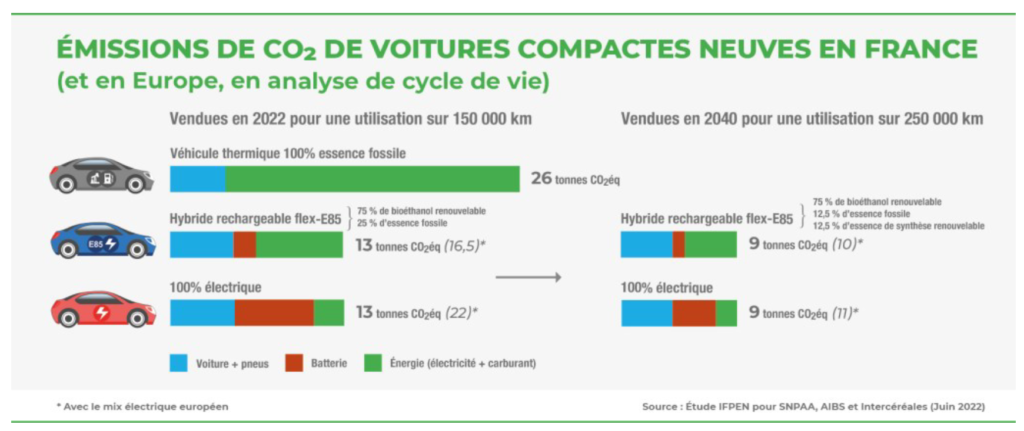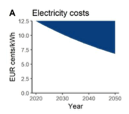

One of the basic advocacy lines for the promotion of bioenergy in transport, biofuels or biogas, is calling for technology neutrality when comparing solutions to reduce the carbon footprint. Only fair that all solutions should be treated with equity in mind, with logic and reason for such scientific or technological matters, avoiding what psychologists, since Daniel Kahneman, Nobel prize in Economy in 2002, call cognitive biases, a typical one being to forget, unintentionally of course, that the whole value chain has to be evaluated.
As illustration, a brave attempt was recently conducted by IFPEN, the French research center on energy, concluding plug-in hybrid vehicles using E85 as liquid fuels (the blue car in the infographic below) are as environmentally efficient as electric vehicles (EV, the red one), even in 2040 and for a 250 000 kilometer-usage:

Between the two, the plug-in hybrid-E85 vehicle is penalized, in terms of Greenhouse Gas (GHG) emissions, by the fuel, the EV by the manufacturing of the battery, technology improvements being counter-balanced by the ever-increasing problem of sourcing materials.
Now, a fair comparison of solutions for the future of mobility is far from easy and straightforward. Many angles have to be taken into account: environment, economics, social, which will likely involve complex, and not always fully mature and fool-proof, techniques like lifecycle analysis for the environmental aspects and models for the economic and social ones. Value chains are extended, cross-sectoral, as we are not only talking of the heart of mobility, the powertrains, but also of the raw materials for these and for the fuels they need, of distribution infrastructure, to name the key building blocks.
Extreme complexity begets subjectivity, short-cuts, cherry-picking of disputable hypothesis for modeling, all of the above potential barbs in the flank of fairness.
An excellent example, found in a recent, serious and public study on the decarbonization of trucks in Europe: the future price of electricity, key to the total cost of operation (TCO), central in the decision by any freight operator to change the truck powertrain, away from diesel and onto electricity. TCO that is, of course, obtained by modeling, the author claiming uncertainty, thus unintentional bias, can be diminished by inputting ranges for the parameters. Below is the range used for this study.

Forget about the price today, in the midst of the worst energy crisis in Europe since the oil shocks of the previous century: 1 € per kWh at the beginning of September 2022 for supply in 2023, when the European average was 22 €cent in 2021. Of course, the war in Ukraine and the subsequent blackmail on the EU by Russia “natural gas (NG) supply v. lift of sanctions” has been the trigger, but many experts have been predicting we have a fossil energy, crude oil and NG, crisis coming, which should not be a surprise if exploration efforts reduce, thus production decreases with time, when demand is kind of slower to decrease. So, if the EU electricity market, where the price is based on the marginal power generator, usually NG-fed, is not reformed, the electricity price is not set for a decrease to pre-pandemic levels. But, furthermore, two things must be kept in mind:
1) If liquid fuels are less used, governments will have to find an alternative source for the lost taxes, and electricity for mobility seems a good candidate,
2) Wind and solar electricity cost of generation has indeed decreased toward competitiveness with fossil, but this renewable energy is intermittent and decentralized, calling for more infrastructure to deal with these limits. Electricity transport infrastructure is quite costly, on top of having social acceptability issues (NIMBY), and this extra investment will also push the price of renewable electricity upwards.
In my opinion, modeling the future price of electricity as optimistically as in the graph above smacks of bias.
And to come back to point 2) above, note that technology-neutrality can somehow be altered by not including public investment in the “fair” comparison. Why? Because of the uncertainty of future, more often than not non-mature, technologies, and the risk posed by related massive new infrastructure investment: public risk, private benefits. Then, models will compare the impact of mostly private money, for low-carbon liquid solutions, and the injection of massive public money for, say, EV recharging infrastructure or renewable electricity high voltage transport lines. Fair?
And there is even a more subtle way to denigrate technology-neutrality, actually quite in use by supporters of magic and unique solutions. The counter-claim is that technology-neutrality, for time-stressed problems, which market supposedly cannot address quickly enough, implies procrastination, thus does not allow ambitious, read costly and uncertain, strategies to be decided in time, with the risk that the cost of inaction is eventually higher than the cost of “less-than-optimum” solutions, the ones they support, of course, regardless of the built-in uncertainties.
Now, if the strategy is clearly defined in terms of outcome, like GHG emission reduction in the EU by 2050, and not in terms of pre-defined solution prescription, like no ICEV on EU roads by 2050, there is no reason why the ecosystem of academics, innovators and industry together should not be able to sort out between the various possible solutions and make sensible recommendations to policymakers, using a fair and equitable approach in the process, and in due course, without losing the precious time we do not have anyway.
Insisting on technology-neutrality is essential to allow a diversity of solutions to emerge for a future sustainable transport and not end up in a new sort of dependency, like the one we suffer from today in Europe with oil products and natural gas from Russia.
Philippe Marchand is a Bioenergy Steering Committee Member of the European Technology and Innovation Platform (ETIP).